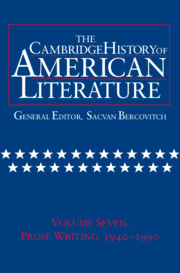Book contents
- Frontmatter
- Introduction
- The Drama, 1940—1990
- Fiction and Society, 1940–1970
- 1 War and the Novel: From World War II to Vietnam
- 2 The New Fiction: From the Home Front to the 1950s
- 3 On and Off the Road: The Outsider as Young Rebel
- 4 Apocalypse Now: A Literature of Extremes
- After the Southern Renascence
- Postmodern Fictions, 1960–1990
- Emergent Literatures
- Appendix: Biographies
- Chronology, 1940–1990
- Bibliography
- Index
1 - War and the Novel: From World War II to Vietnam
from Fiction and Society, 1940–1970
Published online by Cambridge University Press: 28 March 2008
- Frontmatter
- Introduction
- The Drama, 1940—1990
- Fiction and Society, 1940–1970
- 1 War and the Novel: From World War II to Vietnam
- 2 The New Fiction: From the Home Front to the 1950s
- 3 On and Off the Road: The Outsider as Young Rebel
- 4 Apocalypse Now: A Literature of Extremes
- After the Southern Renascence
- Postmodern Fictions, 1960–1990
- Emergent Literatures
- Appendix: Biographies
- Chronology, 1940–1990
- Bibliography
- Index
Summary
Even more than World War I, in which American participation had been brief and casualties relatively light, the Second World War was a watershed, a turning point, in the social history of the nation. In the second war there were five times as many American dead, over half a million in a period of almost four years. This was a total war effort that mobilized virtually every segment of American society. Men and boys from sleepy towns in the Midwest, segregated farms and hamlets in the Deep South, and large ethnic enclaves in the North were thrown together in a huge, highly organized fighting force and sent to the bloody beaches and killing fields of France, Italy, North Africa, and especially the Pacific islands. On V-J Day in August 1945, America had nearly twelve million men under arms; more than sixteen million had served in the course of the war.
Novels written about the war invariably emphasize the shock of a new kind of experience, the social and personal dislocation as well as the shock of blood and carnage. They show how recruits were forced to adjust to the army before they had to face the war itself. To many, the hierarchy and discipline of military life cut against the American grain. Individualism gave way to a harsh, demanding group experience. The men they encountered and the distant places they were sent catapulted them out of the life they knew and thrust them into a larger world.
- Type
- Chapter
- Information
- The Cambridge History of American Literature , pp. 101 - 134Publisher: Cambridge University PressPrint publication year: 1999

